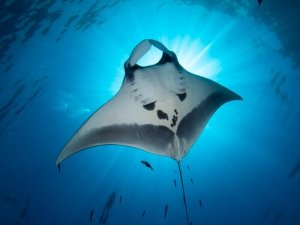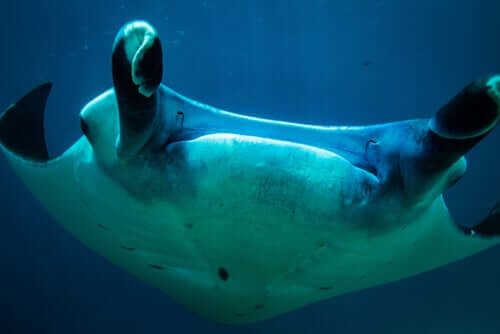The Manta Ray - Beautiful and Mysterious


Written and verified by biochemistry Luz Eduviges Thomas-Romero
The manta ray is a creature that many consider the epitome of marine elegance due to its appearance. Ignorant people are often afraid of this creature due to how its fins resemble “demon horns”, in addition to the fact that the shape of its body resembles a cloak or a mantle.
However, these giants are no threat, because they mainly eat plankton and are rather peaceful creatures. Their gracefulness resembles dancers interpreting an underwater show, as they seem to fly across the sea while doing amazing pirouettes, somersaults and jumps in the air.
This fish has many names around the world. The scientific naming of mantas is quite convoluted and several names were used for both the genus (Ceratoptera, Brachioptilon Daemomanta, and Diabolicthys) and the species (such as vampyrus, americana, johnii, and hamiltoni).
Today we’d like to tell you the amazing features of this type of fish.
Classification of the rays

- The manta ray belongs to the class of Chondrichthyes or cartilaginous fish characterized by having a skeleton composed entirely of cartilage. In fact, this group encompasses different species of sharks and rays.
- Cartilaginous fish don’t have swim bladders or lungs. They breathe through five to seven pairs of gills open to the outside.
- This group of fish has no operculum –this is the bone fin that covers and protects the gills in bonefish. Because of this, they don’t have a mechanism for controlling the entry and exit of water through their gills.
- Because of this, cartilaginous fish must remain in a continuous motion to force water to penetrate the gills. This means that the manta ray is an animal that never stops moving, from the moment they’re born until the day they die.
- Cartilaginous fish or elasmobranch have been around for at least 400 million years.
- Science recognizes two species of rays: the reef manta ray (Manta alfredi) and the giant oceanic manta ray (Manta birostris).
Characteristics of a manta ray

- Manta rays and devilfish both have pectoral fins in the form of wings. They flap them to swim just like birds do when they fly.
- Their gills are in the front of their belly. The head of both species is wide and their eyes are on each side of their body. Their long mouth is in the front and has several rows of small teeth that they don’t use for chewing. Instead, males use them to hold the female during mating.
- There are two structures called cephalic lobes above the mouth. These extend and guide the flow of water to the mouth and optimize the feeding process they perform by filtering water together with plankton. They eat large amounts of it.
- Both species have a whip-shaped tail. However, unlike other species of the same order, the two species of rays lack a poisonous sting in the tail.
- This marine animal is highly intelligent. In fact, scientists say it has the largest brain of all fish. Recently, they showed that manta rays possess the most developed cognitive abilities among fish.
These fish live in tropical latitudes around the world. Interestingly, the manta rays visit “maintenance stations” along the reefs. Once there, “cleaning fish” or opportunistic paddlefish provide them with cleaning services.
How big is a manta ray?

The large flattened body has a center called “disk.” In the case of the reef manta ray, the disk’s reported dimensions of it are 10 to 12 feet wide. In the giant oceanic manta ray, the disk can measure up to 10 feet wide and weigh nearly 3000 pounds.
The most commonly spotted are about 15 feet wide, and can live up to 25 years.
The body of the stingray has a protective mucous membrane. This mucus has two basic functions:
- It acts as a barrier against infections.
- It reduces friction to facilitate the animal’s movement when swimming.
This membrane can be damaged by human contact, so, if you’re near a stingray, don’t touch them.
Another extraordinary characteristic of all cartilaginous fish is that they have an elaborate system of blisters in their skin that are sensitive to low-frequency electrical stimuli. These electroreceptors, known as “ampullae of Lorenzini” are decisive in their orientation towards inanimate electric fields, caused by terrestrial geomagnetism and tides.
System electroreceptors also allow them to detect the electromagnetic fields generated by their potential prey or predators and their congeners during social interactions and mating.
Threats to the manta ray
Humans hunt them either for sport, for their meat, for their oil, or by accident in commercial fishing tasks. Currently, the practice of catching manta ray is restricted and they’re protected in the US.
The protection of the stingray is of economic interest, as they attract a large number of tourists. No doubt that this fish adds beauty, diversity, and mystery to our world.
The manta ray is a creature that many consider the epitome of marine elegance due to its appearance. Ignorant people are often afraid of this creature due to how its fins resemble “demon horns”, in addition to the fact that the shape of its body resembles a cloak or a mantle.
However, these giants are no threat, because they mainly eat plankton and are rather peaceful creatures. Their gracefulness resembles dancers interpreting an underwater show, as they seem to fly across the sea while doing amazing pirouettes, somersaults and jumps in the air.
This fish has many names around the world. The scientific naming of mantas is quite convoluted and several names were used for both the genus (Ceratoptera, Brachioptilon Daemomanta, and Diabolicthys) and the species (such as vampyrus, americana, johnii, and hamiltoni).
Today we’d like to tell you the amazing features of this type of fish.
Classification of the rays

- The manta ray belongs to the class of Chondrichthyes or cartilaginous fish characterized by having a skeleton composed entirely of cartilage. In fact, this group encompasses different species of sharks and rays.
- Cartilaginous fish don’t have swim bladders or lungs. They breathe through five to seven pairs of gills open to the outside.
- This group of fish has no operculum –this is the bone fin that covers and protects the gills in bonefish. Because of this, they don’t have a mechanism for controlling the entry and exit of water through their gills.
- Because of this, cartilaginous fish must remain in a continuous motion to force water to penetrate the gills. This means that the manta ray is an animal that never stops moving, from the moment they’re born until the day they die.
- Cartilaginous fish or elasmobranch have been around for at least 400 million years.
- Science recognizes two species of rays: the reef manta ray (Manta alfredi) and the giant oceanic manta ray (Manta birostris).
Characteristics of a manta ray

- Manta rays and devilfish both have pectoral fins in the form of wings. They flap them to swim just like birds do when they fly.
- Their gills are in the front of their belly. The head of both species is wide and their eyes are on each side of their body. Their long mouth is in the front and has several rows of small teeth that they don’t use for chewing. Instead, males use them to hold the female during mating.
- There are two structures called cephalic lobes above the mouth. These extend and guide the flow of water to the mouth and optimize the feeding process they perform by filtering water together with plankton. They eat large amounts of it.
- Both species have a whip-shaped tail. However, unlike other species of the same order, the two species of rays lack a poisonous sting in the tail.
- This marine animal is highly intelligent. In fact, scientists say it has the largest brain of all fish. Recently, they showed that manta rays possess the most developed cognitive abilities among fish.
These fish live in tropical latitudes around the world. Interestingly, the manta rays visit “maintenance stations” along the reefs. Once there, “cleaning fish” or opportunistic paddlefish provide them with cleaning services.
How big is a manta ray?

The large flattened body has a center called “disk.” In the case of the reef manta ray, the disk’s reported dimensions of it are 10 to 12 feet wide. In the giant oceanic manta ray, the disk can measure up to 10 feet wide and weigh nearly 3000 pounds.
The most commonly spotted are about 15 feet wide, and can live up to 25 years.
The body of the stingray has a protective mucous membrane. This mucus has two basic functions:
- It acts as a barrier against infections.
- It reduces friction to facilitate the animal’s movement when swimming.
This membrane can be damaged by human contact, so, if you’re near a stingray, don’t touch them.
Another extraordinary characteristic of all cartilaginous fish is that they have an elaborate system of blisters in their skin that are sensitive to low-frequency electrical stimuli. These electroreceptors, known as “ampullae of Lorenzini” are decisive in their orientation towards inanimate electric fields, caused by terrestrial geomagnetism and tides.
System electroreceptors also allow them to detect the electromagnetic fields generated by their potential prey or predators and their congeners during social interactions and mating.
Threats to the manta ray
Humans hunt them either for sport, for their meat, for their oil, or by accident in commercial fishing tasks. Currently, the practice of catching manta ray is restricted and they’re protected in the US.
The protection of the stingray is of economic interest, as they attract a large number of tourists. No doubt that this fish adds beauty, diversity, and mystery to our world.
All cited sources were thoroughly reviewed by our team to ensure their quality, reliability, currency, and validity. The bibliography of this article was considered reliable and of academic or scientific accuracy.
- Jesús Gómez-García, M., & Godínez-Siordia, D. E. (2013). Aspectos biologicos y ecologicos de la manta gigante Manta birostris (Walbaum, 1792). Juyyaania, 1(1), 31-41.
- Rojas, E. R. R. (2013). La Mantarraya Gigante (Manta Birostris): Esplendor Más Allá Del Tamaño. Trends Ecol Evol, 28(6), 359-366.
- Ari C and D’Agostino DP (2016), Contingency Checking and Self-Directed Behaviors in Giant Manta Rays: Do Elasmobranchs Have Self-awareness? Journal of Ethology, 34: 167.
- Meyer, W., & Seegers, U. (2012). Basics of skin structure and function in elasmobranchs: a review. Journal of fish biology, 80(5), 1940-1967.
This text is provided for informational purposes only and does not replace consultation with a professional. If in doubt, consult your specialist.








